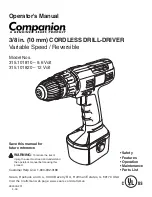
After setting the shoe, tighten it by returning the shoe lever to its
oringinal position. NOTE: The shoe will be difficult to bevel at first.
Ensure the shoe lever is up and the two arrows shown are aligned.
Gently rock the shoe from side to side to loosen.
At 0˚, the shoe may slide back to allow for cutting in tight work areas. Lift
the shoe lever, slide the shoe back and depress the lever to lock. If
necessary tighten the shoe lever with the screw (B).
Dust Blower (Fig. 4)
Your jig saw is equipped with a dust blower to clear the cutting area of
saw dust. To turn on the blower, slide the switch to the upper position.
To turn it off, slide the switch to the lower position.
Removable Shoe Cover (Fig. 5)
A plastic shoe cover is included. Use this cover when cutting surfaces
that scratch easily, such as laminates or veneer. Install the shoe as
shown in Fig. 5. The tabs slide under the slots on the shoe. Place the
shoe cover on hte shoe and slide the cover toward the back of the tool
to lock it in place.
Attaching Blades (Fig. 7)
UNPLUG TOOL. To remove the blade, lift the knob (Figure 6) on the top
of the jig saw approximately 1/2". Rotate the knob counterclockwise
until the clamp is open. Do not force the knob once it stops. Insert the
blade as shown. Make sure the back edge of the blade fits into the
support roller. Tighten clamp by turning top knob clockwise until you
hear a clicking sound. Push knob down.
Pocket Cutting (Figs. 8)
A pocket cut is an easy method of making an inside cut. The saw can
be inserted directly into a panel or board without first drilling a lead or
pilot hole. In pocket cutting measure the surface to be cut and mark
7
English
FIG. 3
A
B
FIG. 4
FIG. 6
FIG. 5
FIG. 7











































